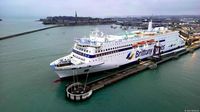As Ukraine prepares to modernize its energy grid, significant changes are set to take place starting July 1, 2025. The National Energy and Utilities Regulatory Commission of Ukraine (NCERC) has announced a transition to a nominal voltage of 230/400 volts in the country's power grid. This shift is part of a broader effort to align Ukraine's energy standards with European norms, which is expected to enhance the quality of electricity supply across the nation.
In March 2024, the previous standard, DSTU EN 50160:2014, which defined the characteristics of voltage supply in electrical networks, was deemed obsolete. Subsequently, a new standard compatible with the European translation method, EN 50160, was approved in May 2024. This change aims to improve the reliability and quality of electricity supply, which is crucial for both residential and industrial consumers.
During a meeting on April 15, 2025, the NCERC approved amendments to the distribution system code to adapt to these new technical requirements. The commission believes that these adjustments will positively impact the quality of electricity indicators. As stated by the NCERC, "Starting from July 1, 2025, European methods for determining the quality standards of electricity supply will be implemented in Ukraine, particularly the transition to a nominal voltage of 400/230 volts." This transition includes setting clear limits on permissible voltage deviations, which will range from 253 to 230 volts (±10% of the nominal value).
One of the anticipated benefits of this modernization is a reduction in the risk of damage to sensitive household appliances, which often suffer from voltage fluctuations. This stability is expected to decrease the necessity for additional protective measures such as stabilizers, ultimately leading to greater energy efficiency. As appliances operate more efficiently without overloads and energy losses, electricity consumption is projected to rise.
In a related development, a group of lawmakers registered a bill in October 2024 titled "On Amendments to Certain Laws of Ukraine Regarding the Unification of Electricity Markets in Ukraine and Integration into the European Energy Network." This bill aims to ensure that decisions made by the Agency for the Cooperation of Energy Regulators (ACER) will be binding for the National Energy Regulatory Authority (NEURC) and market participants, further integrating Ukraine into the European energy framework.
Meanwhile, across Europe, a notable shift is occurring in the maritime transportation sector. In Bonn, Germany, the "Reinfehre Mondorf" ferry has transitioned from diesel to electric engines, marking a significant step in reducing emissions and promoting sustainable transport. Since February 2025, this ferry has been powered by electric engines with a capacity of 290 kilowatts, equivalent to 400 horsepower. The Rhine River, at this point, spans 400 meters, and the ferry takes approximately two minutes to cross.
The ferry is equipped with a battery that can store 1000 kilowatts per hour, which is comparable to the battery capacity of 14 electric cars. During nighttime, the battery is charged at the pier using renewable energy sources. The operation of the ferry for 14 hours daily requires around 600 kilowatts, making this transition not only environmentally friendly but also economically viable.
Ilmar Mübach Audikoven, the technical director of "Lux Werft and Schifffahrt," which operates the ferry, emphasized the long-term cost benefits of electric propulsion. He noted, "Without support, costs would have been prohibitively high," referring to the substantial financial backing from the German government that covered about 80% of the conversion costs for the 60-year-old ferry.
This trend towards electric ferries is gaining momentum across Germany and internationally, as countries seek to reduce their carbon footprints. The Norwegian government has been a pioneer in this area, promoting electric technology for ships, ferries, and fishing boats for over a decade. Their goal is to significantly reduce carbon dioxide emissions from maritime sectors by 2030 through financial support and regulatory measures.
In Norway, electric ferries are becoming increasingly common, with one of the largest electric ferries, "Basto Electric," operating since 2020. This ferry can carry over 200 cars and 600 passengers, relying entirely on battery power. The trend is not limited to Norway; globally, over 1,000 ships are now powered by electric or hybrid engines, with many more under construction.
However, challenges remain for electric maritime transport, especially regarding long-distance travel. While technically feasible for shorter distances, the current battery systems pose limitations for longer voyages. For instance, crossing the Atlantic from New York to Lisbon (approximately 8,300 kilometers) is possible, but a journey from Shanghai to Venice (30,000 kilometers) is not currently viable with existing technologies.
As a solution, clean methanol is emerging as a promising alternative fuel for long-distance shipping. The Danish shipping company Mærsk has recently begun operating the first methanol-powered cargo ship, produced using renewable energy sources such as solar and wind. Experts anticipate that more facilities for clean biofuel production will be necessary in the future.
According to the European Commission, the maritime sector contributes approximately 2.8% of global carbon dioxide emissions. Transitioning to electric engines could drastically reduce these emissions and improve air quality, particularly in coastal regions. Roger Holm, president of Wärtsilä Marine, a Finnish company specializing in ship equipment, remarked, "The horizons are wide for electric ferries, as demand for electric and hybrid systems increases year after year." Between 2019 and 2024, the number of orders in this sector has quadrupled.
Stefano Somadosi, managing director of Net Power Marine, noted that the next two decades will see a revolution in battery technologies and a rapid expansion of the market due to political support and innovation competition. He predicts that the Asia-Pacific region will lead the global electric ferry market, followed by Europe, which is strongly driven by the push for decarbonization in maritime transport.
In summary, Ukraine's shift to European energy standards and the growing trend of electric ferries in Europe and beyond reflect a significant movement towards sustainable energy practices. As nations invest in modernizing their infrastructure and embracing innovative technologies, the future of energy and transportation looks increasingly green.

